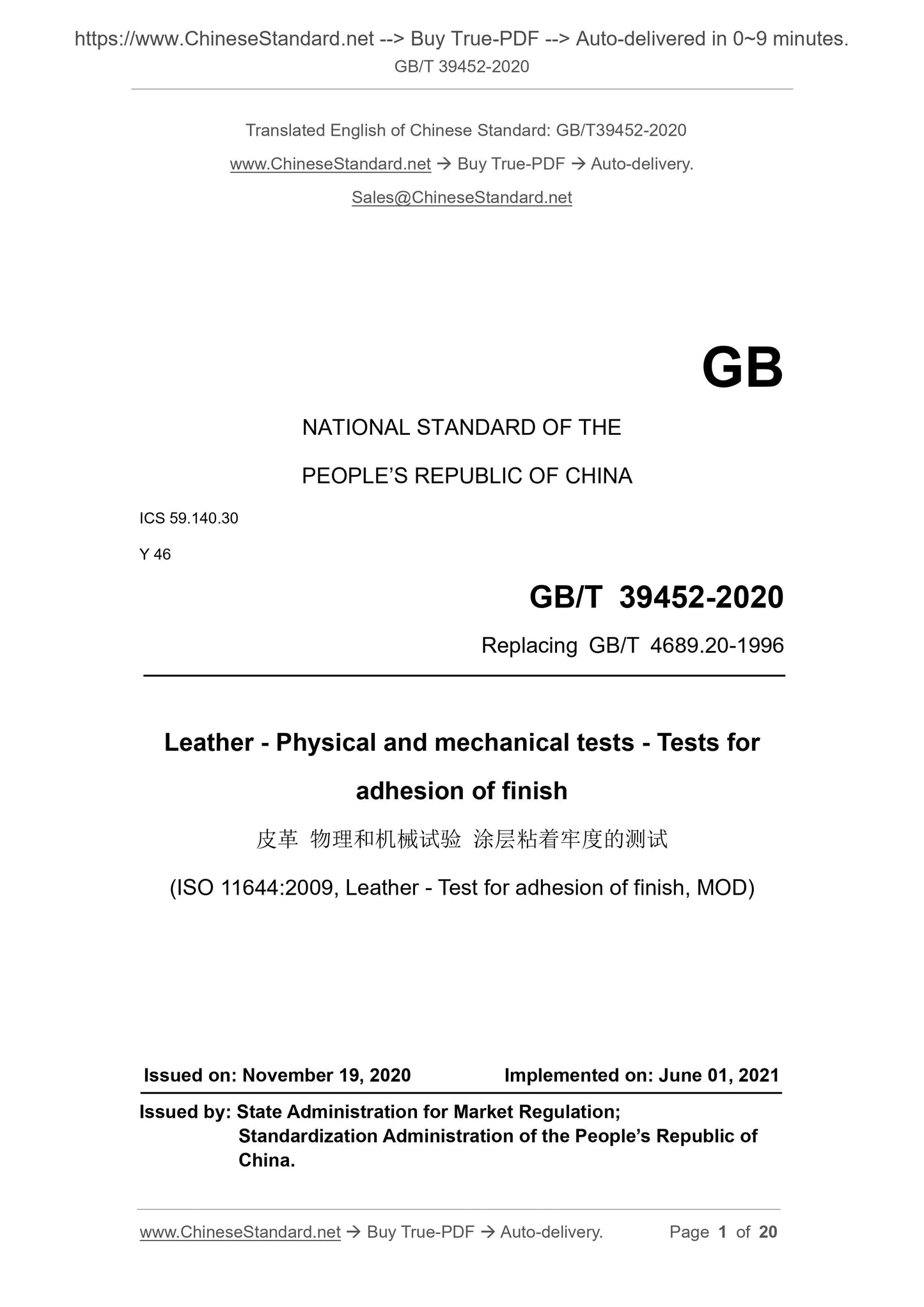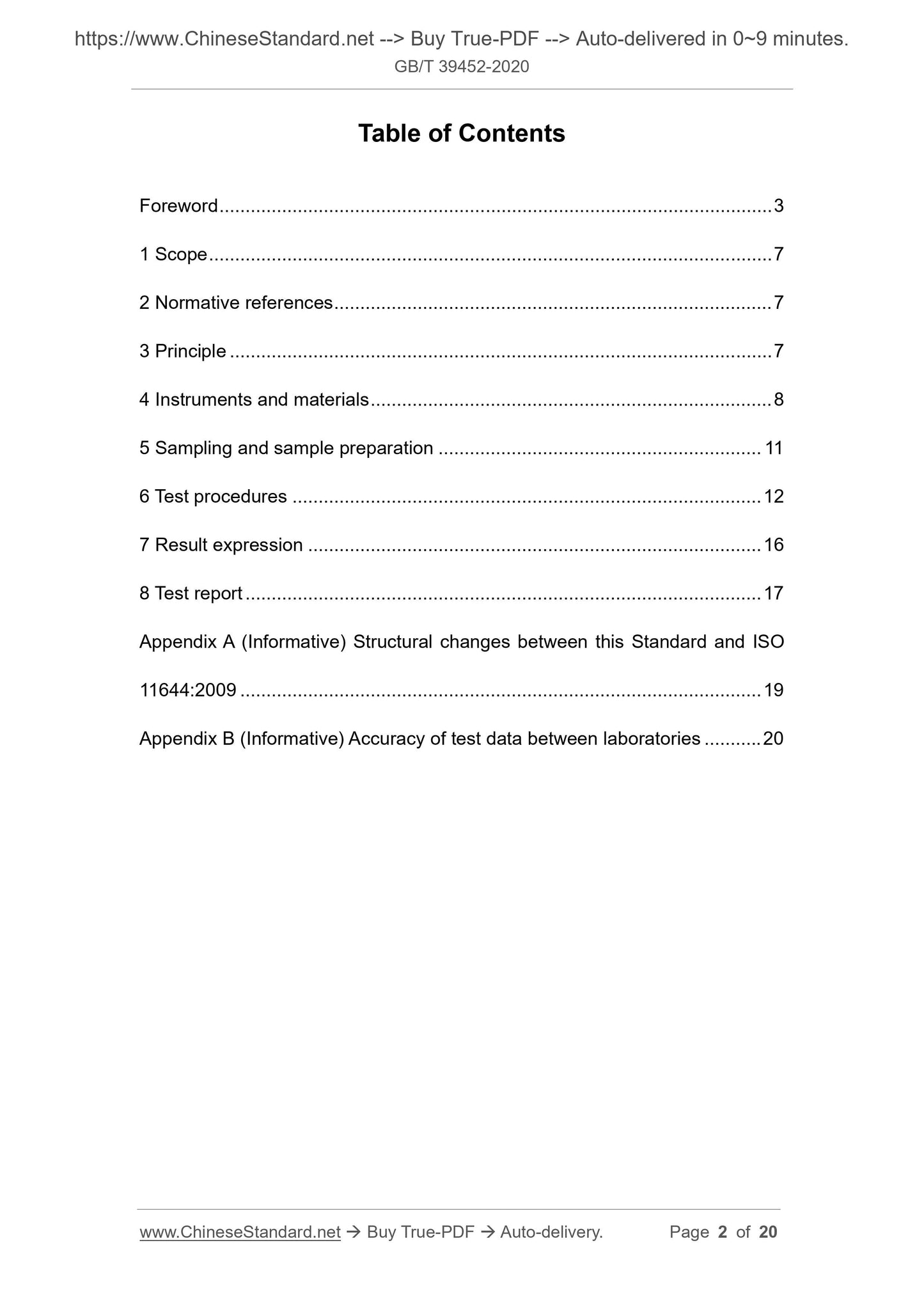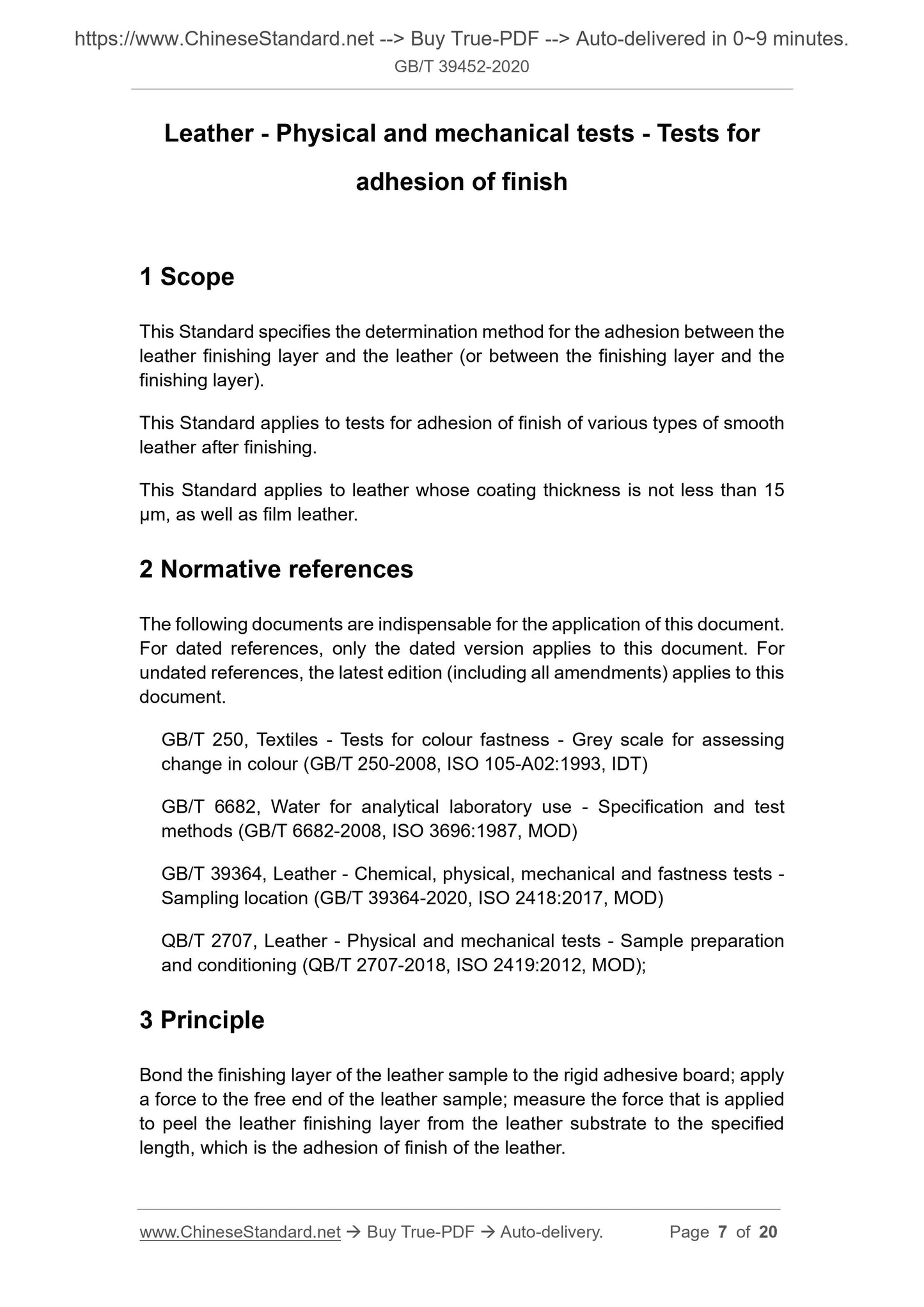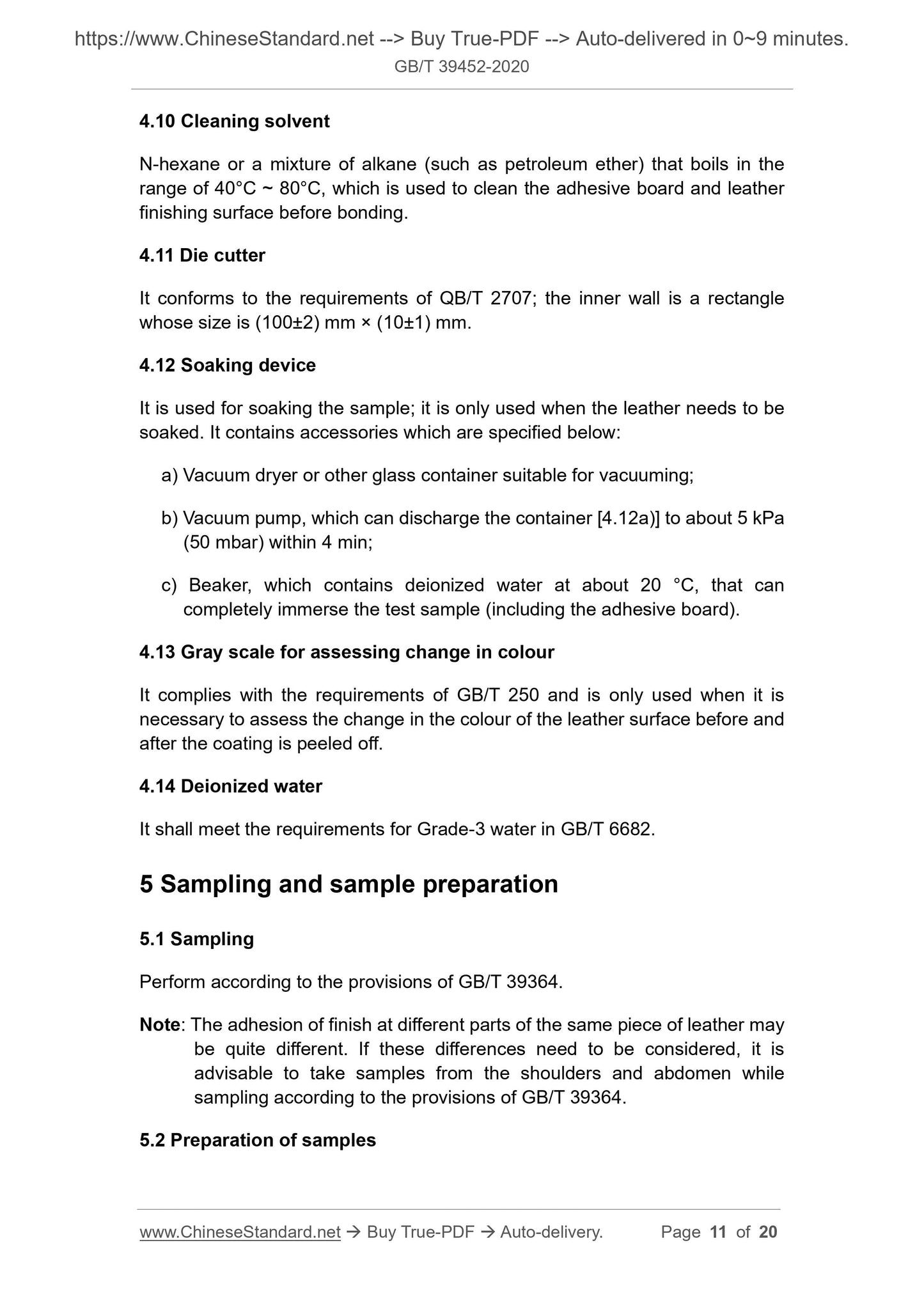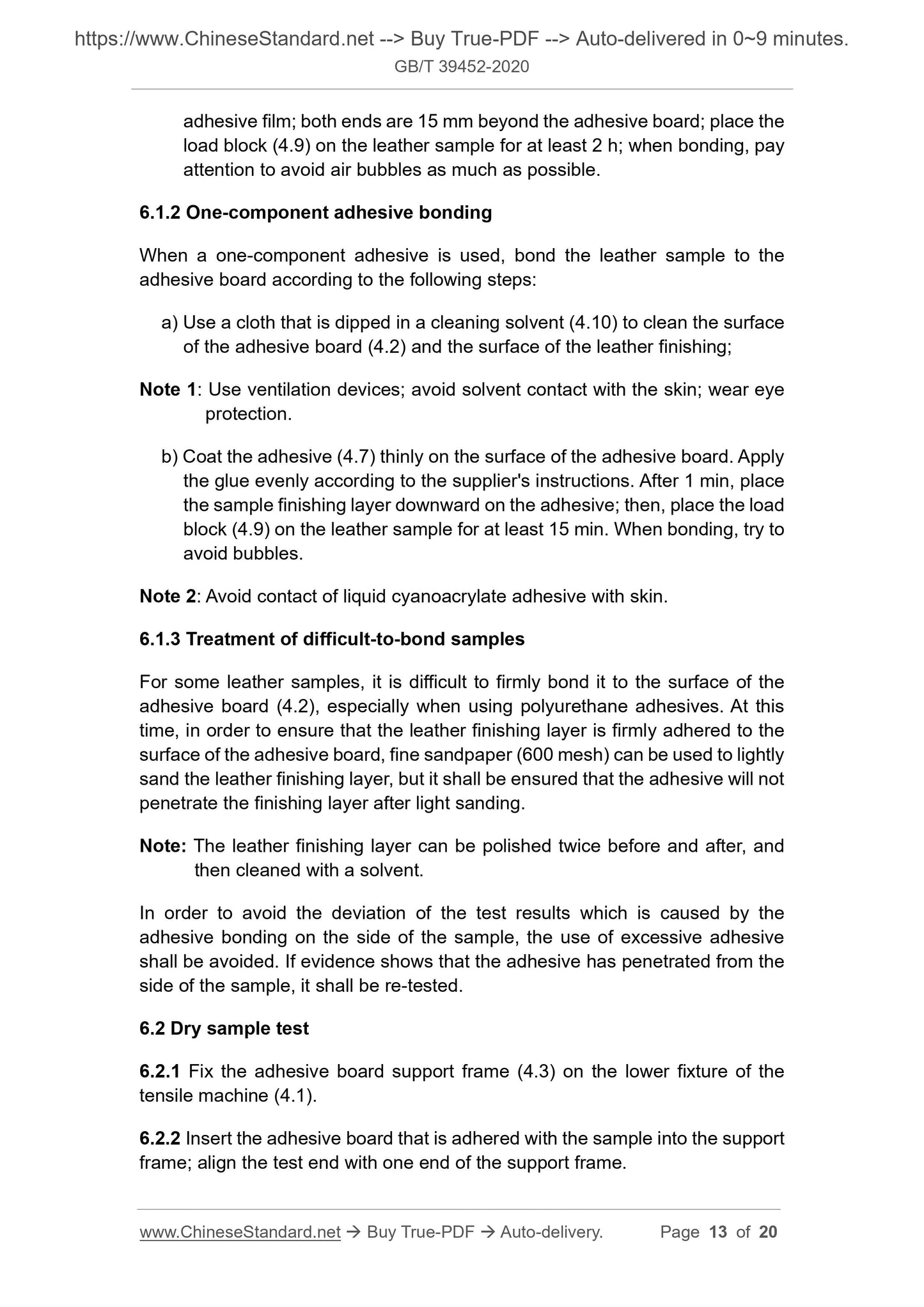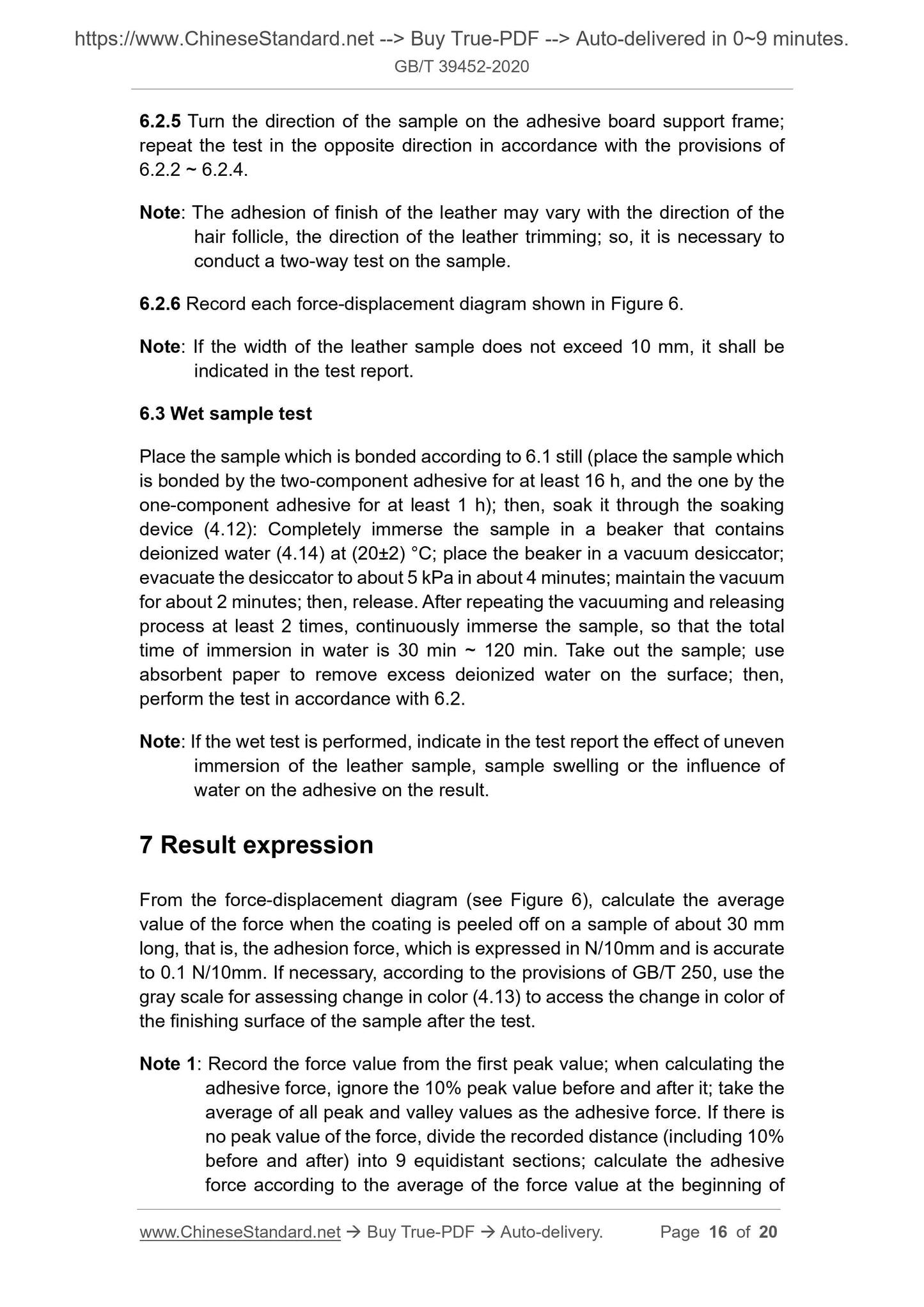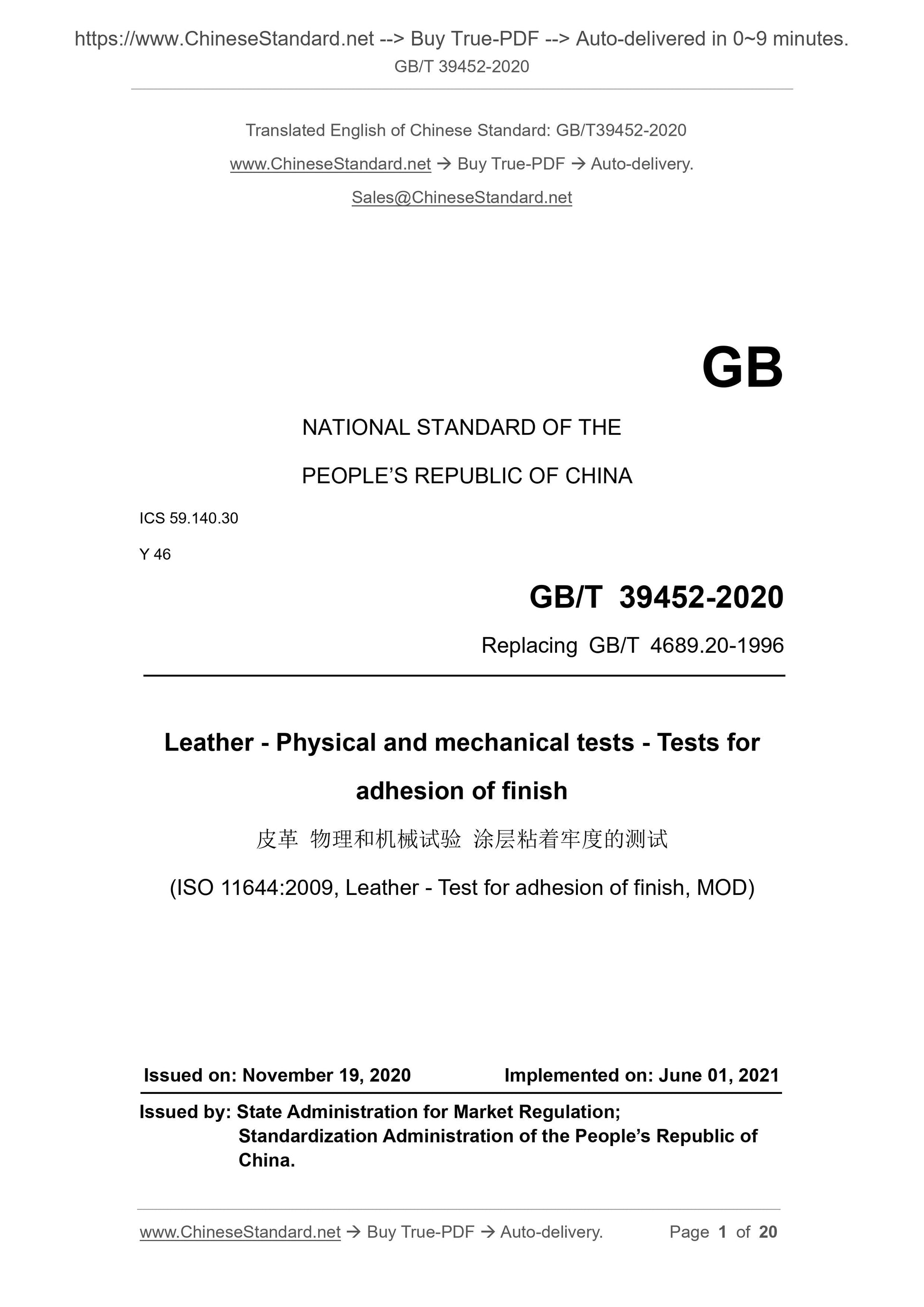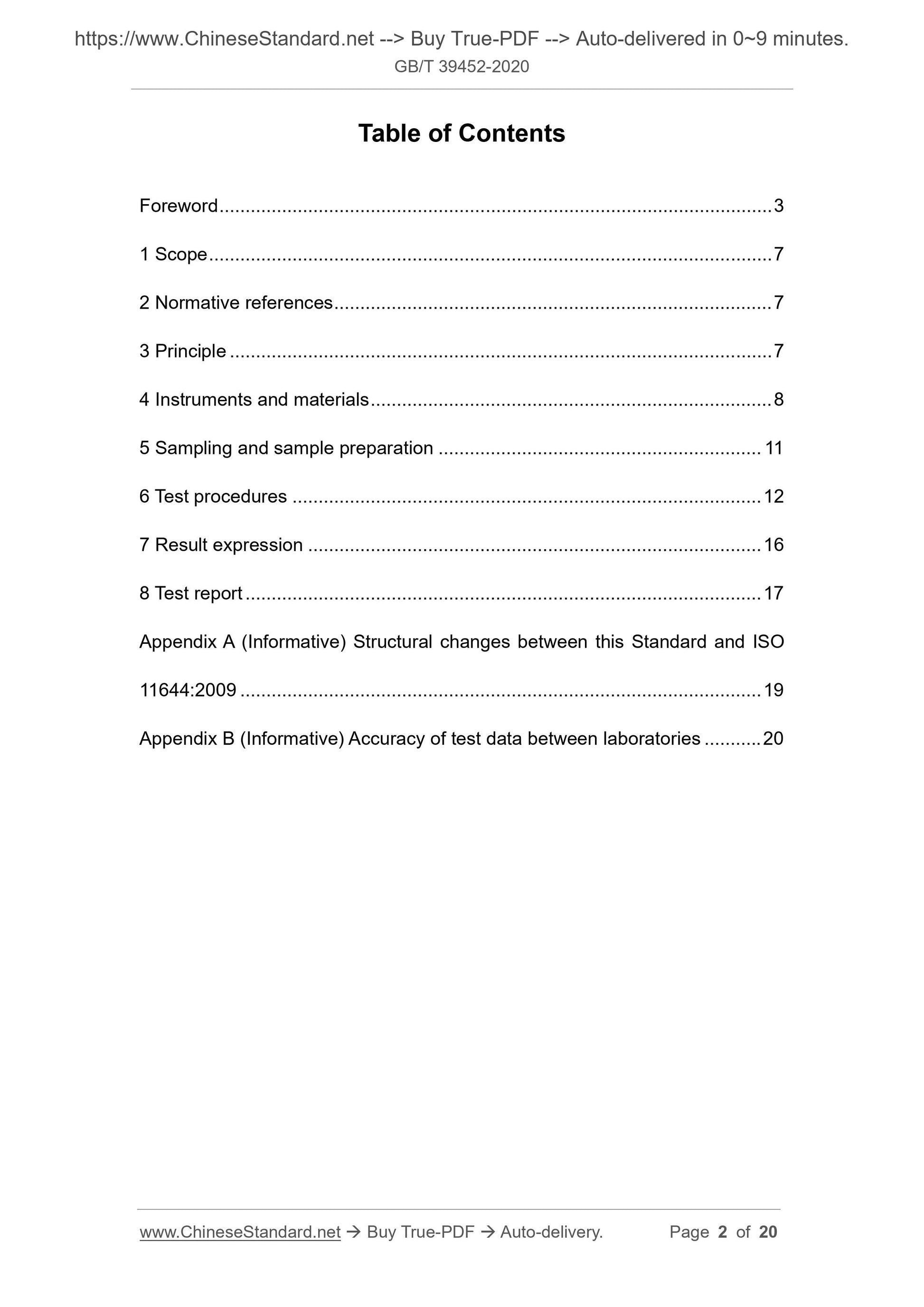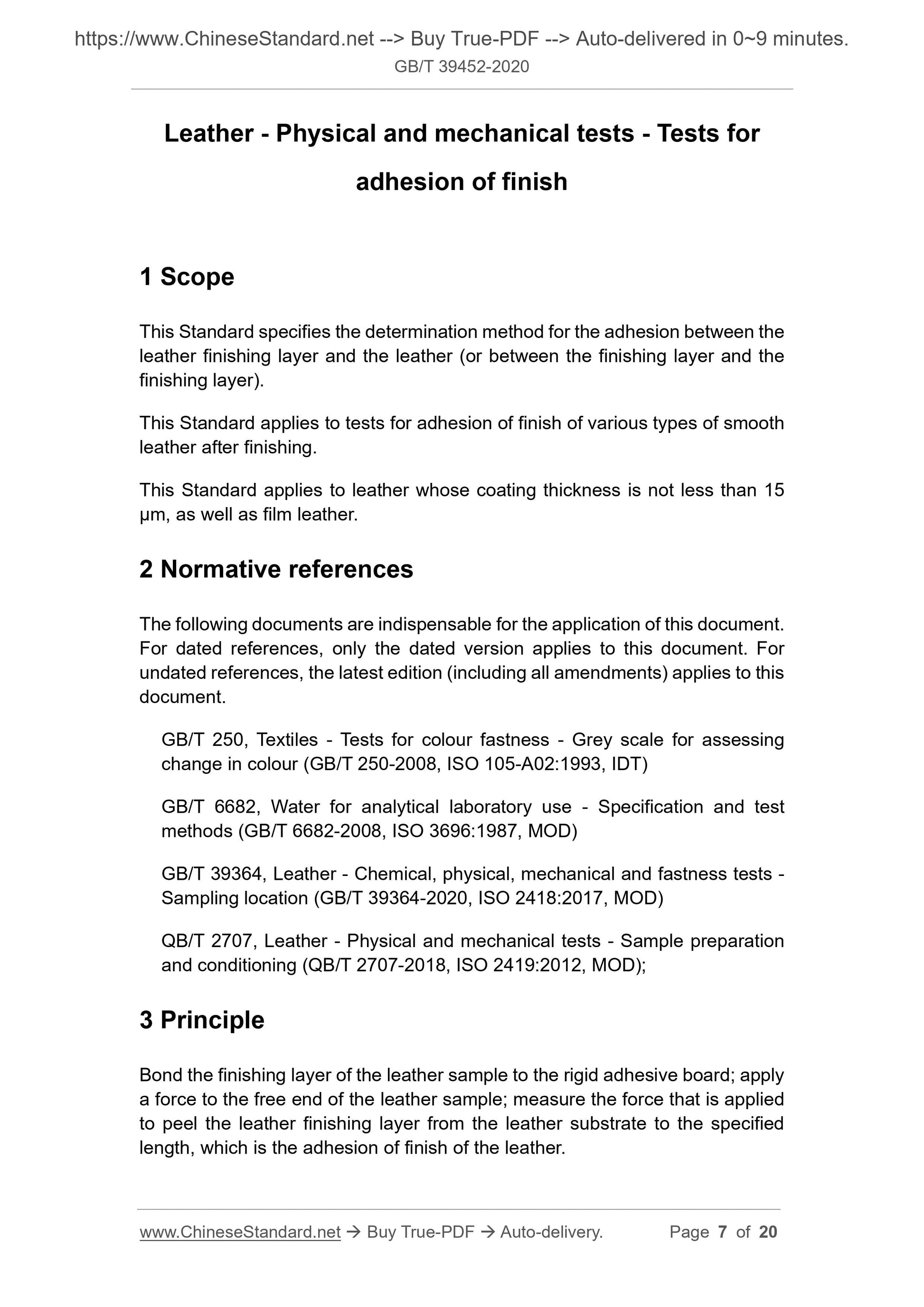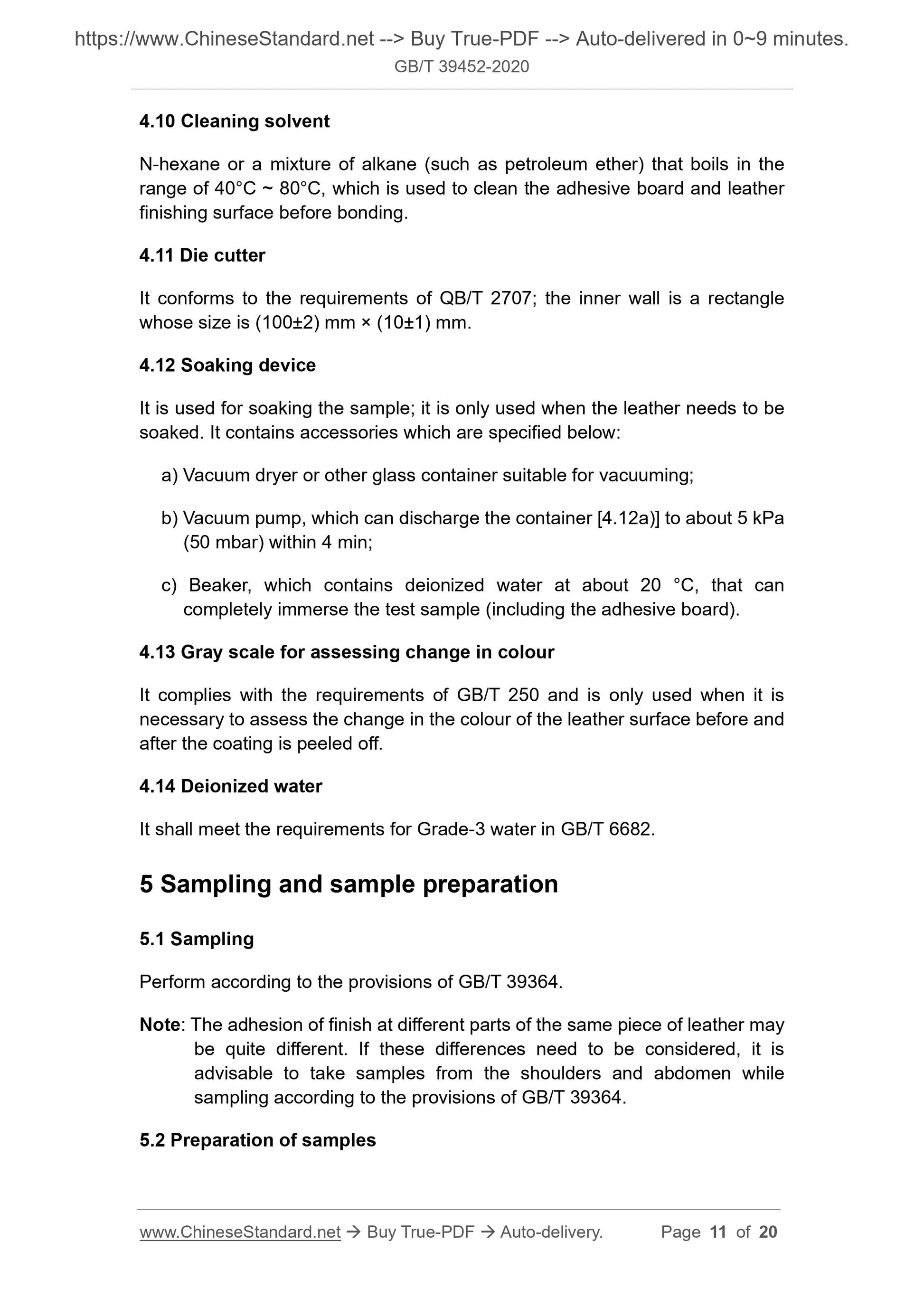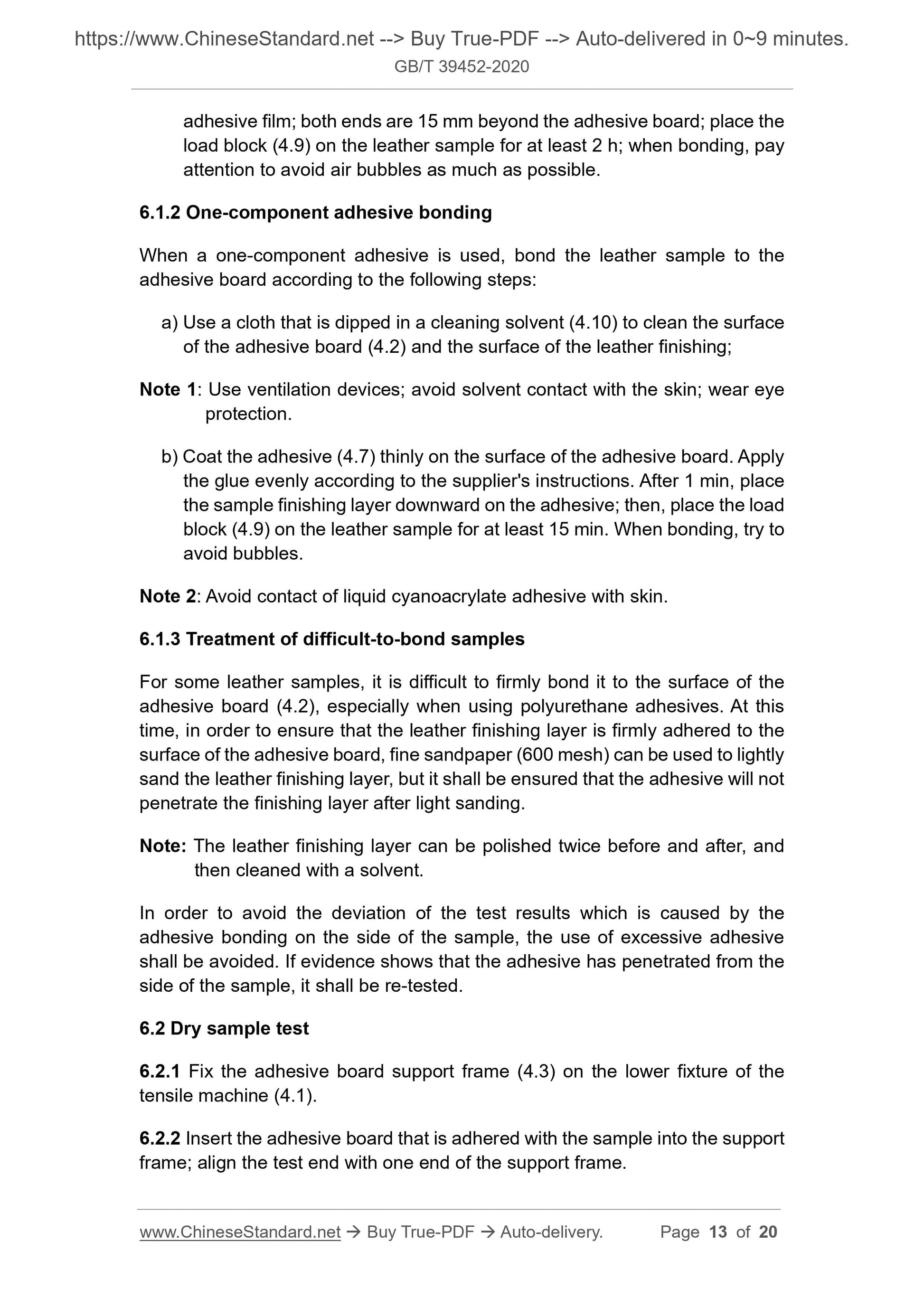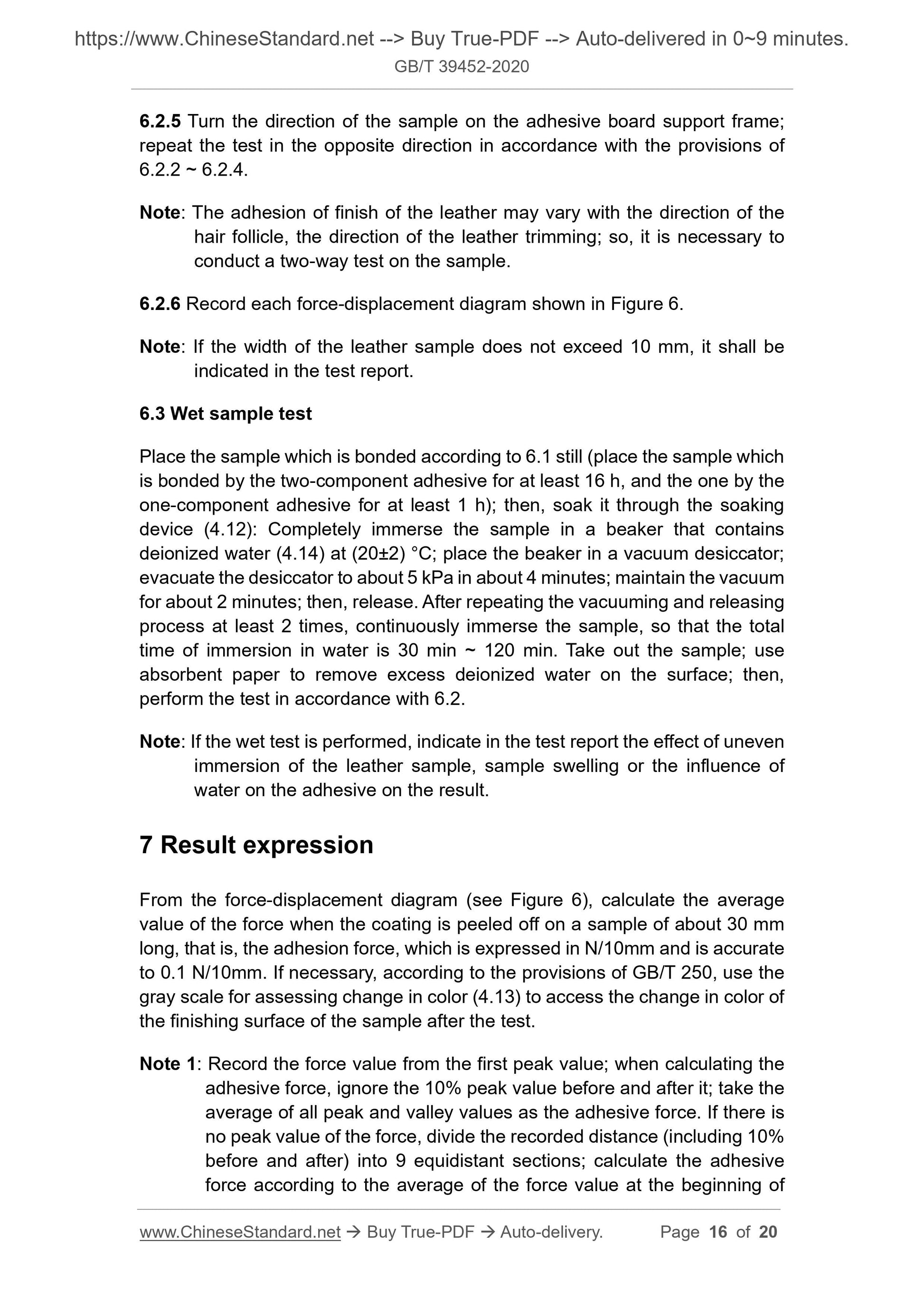1
/
of
6
www.ChineseStandard.us -- Field Test Asia Pte. Ltd.
GB/T 39452-2020 English PDF (GB/T39452-2020)
GB/T 39452-2020 English PDF (GB/T39452-2020)
Regular price
$225.00
Regular price
Sale price
$225.00
Unit price
/
per
Shipping calculated at checkout.
Couldn't load pickup availability
GB/T 39452-2020: Leather - Physical and mechanical tests - Tests for adhesion of finish
Delivery: 9 seconds. Download (& Email) true-PDF + Invoice.
Get Quotation: Click GB/T 39452-2020 (Self-service in 1-minute)
Historical versions (Master-website): GB/T 39452-2020
Preview True-PDF (Reload/Scroll-down if blank)
GB/T 39452-2020
GB
NATIONAL STANDARD OF THE
PEOPLE’S REPUBLIC OF CHINA
ICS 59.140.30
Y 46
Replacing GB/T 4689.20-1996
Leather - Physical and mechanical tests - Tests for
adhesion of finish
(ISO 11644:2009, Leather - Test for adhesion of finish, MOD)
ISSUED ON: NOVEMBER 19, 2020
IMPLEMENTED ON: JUNE 01, 2021
Issued by: State Administration for Market Regulation;
Standardization Administration of the People’s Republic of
China.
Table of Contents
Foreword ... 3
1 Scope ... 7
2 Normative references ... 7
3 Principle ... 7
4 Instruments and materials ... 8
5 Sampling and sample preparation ... 11
6 Test procedures ... 12
7 Result expression ... 16
8 Test report ... 17
Appendix A (Informative) Structural changes between this Standard and ISO
11644:2009 ... 19
Appendix B (Informative) Accuracy of test data between laboratories ... 20
Leather - Physical and mechanical tests - Tests for
adhesion of finish
1 Scope
This Standard specifies the determination method for the adhesion between the
leather finishing layer and the leather (or between the finishing layer and the
finishing layer).
This Standard applies to tests for adhesion of finish of various types of smooth
leather after finishing.
This Standard applies to leather whose coating thickness is not less than 15
μm, as well as film leather.
2 Normative references
The following documents are indispensable for the application of this document.
For dated references, only the dated version applies to this document. For
undated references, the latest edition (including all amendments) applies to this
document.
GB/T 250, Textiles - Tests for colour fastness - Grey scale for assessing
change in colour (GB/T 250-2008, ISO 105-A02:1993, IDT)
GB/T 6682, Water for analytical laboratory use - Specification and test
methods (GB/T 6682-2008, ISO 3696:1987, MOD)
GB/T 39364, Leather - Chemical, physical, mechanical and fastness tests -
Sampling location (GB/T 39364-2020, ISO 2418:2017, MOD)
QB/T 2707, Leather - Physical and mechanical tests - Sample preparation
and conditioning (QB/T 2707-2018, ISO 2419:2012, MOD);
3 Principle
Bond the finishing layer of the leather sample to the rigid adhesive board; apply
a force to the free end of the leather sample; measure the force that is applied
to peel the leather finishing layer from the leather substrate to the specified
length, which is the adhesion of finish of the leather.
4.10 Cleaning solvent
N-hexane or a mixture of alkane (such as petroleum ether) that boils in the
range of 40°C ~ 80°C, which is used to clean the adhesive board and leather
finishing surface before bonding.
4.11 Die cutter
It conforms to the requirements of QB/T 2707; the inner wall is a rectangle
whose size is (100±2) mm × (10±1) mm.
4.12 Soaking device
It is used for soaking the sample; it is only used when the leather needs to be
soaked. It contains accessories which are specified below:
a) Vacuum dryer or other glass container suitable for vacuuming;
b) Vacuum pump, which can discharge the container [4.12a)] to about 5 kPa
(50 mbar) within 4 min;
c) Beaker, which contains deionized water at about 20 °C, that can
completely immerse the test sample (including the adhesive board).
4.13 Gray scale for assessing change in colour
It complies with the requirements of GB/T 250 and is only used when it is
necessary to assess the change in the colour of the leather surface before and
after the coating is peeled off.
4.14 Deionized water
It shall meet the requirements for Grade-3 water in GB/T 6682.
5 Sampling and sample preparation
5.1 Sampling
Perform according to the provisions of GB/T 39364.
Note: The adhesion of finish at different parts of the same piece of leather may
be quite different. If these differences need to be considered, it is
advisable to take samples from the shoulders and abdomen while
sampling according to the provisions of GB/T 39364.
5.2 Preparation of samples
adhesive film; both ends are 15 mm beyond the adhesive board; place the
load block (4.9) on the leather sample for at least 2 h; when bonding, pay
attention to avoid air bubbles as much as possible.
6.1.2 One-component adhesive bonding
When a one-component adhesive is used, bond the leather sample to the
adhesive board according to the following steps:
a) Use a cloth that is dipped in a cleaning solvent (4.10) to clean the surface
of the adhesive board (4.2) and the surface of the leather finishing;
Note 1: Use ventilation devices; avoid solvent contact with the skin; wear eye
protection.
b) Coat the adhesive (4.7) thinly on the surface of the adhesive board. Apply
the glue evenly according to the supplier's instructions. After 1 min, place
the sample finishing layer downward on the adhesive; then, place the load
block (4.9) on the leather sample for at least 15 min. When bonding, try to
avoid bubbles.
Note 2: Avoid contact of liquid cyanoacrylate adhesive with skin.
6.1.3 Treatment of difficult-to-bond samples
For some leather samples, it is difficult to firmly bond it to the surface of the
adhesive board (4.2), especially when using polyurethane adhesives. At this
time, in order to ensure that the leather finishing layer is firmly adhered to the
surface of the adhesive board, fine sandpaper (600 mesh) can be used to lightly
sand the leather finishing layer, but it shall be ensured that the adhesive will not
penetrate the finishing layer after light sanding.
Note: The leather finishing layer can be polished twice before and after, and
then cleaned with a solvent.
In order to avoid the deviation of the test results which is caused by the
adhesive bonding on the side of the sample, the use of excessive adhesive
shall be avoided. If evidence shows that the adhesive has penetrated from the
side of the sample, it shall be re-tested.
6.2 Dry sample test
6.2.1 Fix the adhesive board support frame (4.3) on the lower fixture of the
tensile machine (4.1).
6.2.2 Insert the adhesive board that is adhered with the sample into the support
frame; align the test end with one end of the support frame.
6.2.5 Turn the direction of the sample on the adhesive board support frame;
repeat the test in the opposite direction in accordance with the provisions of
6.2.2 ~ 6.2.4.
Note: The adhesion of finish of the leather may vary with the direction of the
hair follicle, the direction of the leather trimming; so, it is necessary to
conduct a two-way test on the sample.
6.2.6 Record each force-displacement diagram shown in Figure 6.
Note: If the width of the leather sample does not exceed 10 mm, it shall be
indicated in the test report.
6.3 Wet sample test
Place the sample which is bonded according to 6.1 still (place the sample which
is bonded by the two-component adhesive for at least 16 h, and the one by the
one-component adhesive for at least 1 h); then, soak it through the soaking
device (4.12): Completely immerse the sample in a beaker that contains
deionized water (4.14) at (20±2) °C; place the beaker in a vacuum desiccator;
evacuate the desiccator to about 5 kPa in about 4 minutes; maintain the vacuum
for about 2 minutes; then, release. After repeating the vacuuming and releasing
process at least 2 times, continuously immerse the sample, so that the total
time of immersion in water is 30 min ~ 120 min. Take out the sample; use
absorbent paper to remove excess deionized water on the surface; then,
perform the test in accordance with 6.2.
Note: If the wet test is performed, indicate in the test report the effect of uneven
immersion of the leather sample, sample swelling or the influence of
water on the adhesive on the result.
7 Result expression
From the force-displacement diagram (see Figure 6), calculate the average
value of the force when the coating is peeled off on a sample of about 30 mm
long, that is, the adhesion force, which is expressed in N/10mm and is accurate
to 0.1 N/10mm. If necessary, according to the provisions of GB/T 250, use the
gray scale for assessing change in color (4.13) to access the change in color of
the finishing surface of the sample after the test.
Note 1: Record the force value from the first peak value; when calculating the
adhesive force, ignore the 10% peak value before and after it; take the
average of all peak and valley values as the adhesive force. If there is
no peak value of the force, divide the recorded distance (including 10%
before and after) into 9 equidistant sections; calculate the adhesive
force according to the average of the force value at the beginning of
GB/T 39452-2020
GB
NATIONAL STANDARD OF THE
PEOPLE’S REPUBLIC OF CHINA
ICS 59.140.30
Y 46
Replacing GB/T 4689.20-1996
Leather - Physical and mechanical tests - Tests for
adhesion of finish
(ISO 11644:2009, Leather - Test for adhesion of finish, MOD)
ISSUED ON: NOVEMBER 19, 2020
IMPLEMENTED ON: JUNE 01, 2021
Issued by: State Administration for Market Regulation;
Standardization Administration of the People’s Republic of
China.
Table of Contents
Foreword ... 3
1 Scope ... 7
2 Normative references ... 7
3 Principle ... 7
4 Instruments and materials ... 8
5 Sampling and sample preparation ... 11
6 Test procedures ... 12
7 Result expression ... 16
8 Test report ... 17
Appendix A (Informative) Structural changes between this Standard and ISO
11644:2009 ... 19
Appendix B (Informative) Accuracy of test data between laboratories ... 20
Leather - Physical and mechanical tests - Tests for
adhesion of finish
1 Scope
This Standard specifies the determination method for the adhesion between the
leather finishing layer and the leather (or between the finishing layer and the
finishing layer).
This Standard applies to tests for adhesion of finish of various types of smooth
leather after finishing.
This Standard applies to leather whose coating thickness is not less than 15
μm, as well as film leather.
2 Normative references
The following documents are indispensable for the application of this document.
For dated references, only the dated version applies to this document. For
undated references, the latest edition (including all amendments) applies to this
document.
GB/T 250, Textiles - Tests for colour fastness - Grey scale for assessing
change in colour (GB/T 250-2008, ISO 105-A02:1993, IDT)
GB/T 6682, Water for analytical laboratory use - Specification and test
methods (GB/T 6682-2008, ISO 3696:1987, MOD)
GB/T 39364, Leather - Chemical, physical, mechanical and fastness tests -
Sampling location (GB/T 39364-2020, ISO 2418:2017, MOD)
QB/T 2707, Leather - Physical and mechanical tests - Sample preparation
and conditioning (QB/T 2707-2018, ISO 2419:2012, MOD);
3 Principle
Bond the finishing layer of the leather sample to the rigid adhesive board; apply
a force to the free end of the leather sample; measure the force that is applied
to peel the leather finishing layer from the leather substrate to the specified
length, which is the adhesion of finish of the leather.
4.10 Cleaning solvent
N-hexane or a mixture of alkane (such as petroleum ether) that boils in the
range of 40°C ~ 80°C, which is used to clean the adhesive board and leather
finishing surface before bonding.
4.11 Die cutter
It conforms to the requirements of QB/T 2707; the inner wall is a rectangle
whose size is (100±2) mm × (10±1) mm.
4.12 Soaking device
It is used for soaking the sample; it is only used when the leather needs to be
soaked. It contains accessories which are specified below:
a) Vacuum dryer or other glass container suitable for vacuuming;
b) Vacuum pump, which can discharge the container [4.12a)] to about 5 kPa
(50 mbar) within 4 min;
c) Beaker, which contains deionized water at about 20 °C, that can
completely immerse the test sample (including the adhesive board).
4.13 Gray scale for assessing change in colour
It complies with the requirements of GB/T 250 and is only used when it is
necessary to assess the change in the colour of the leather surface before and
after the coating is peeled off.
4.14 Deionized water
It shall meet the requirements for Grade-3 water in GB/T 6682.
5 Sampling and sample preparation
5.1 Sampling
Perform according to the provisions of GB/T 39364.
Note: The adhesion of finish at different parts of the same piece of leather may
be quite different. If these differences need to be considered, it is
advisable to take samples from the shoulders and abdomen while
sampling according to the provisions of GB/T 39364.
5.2 Preparation of samples
adhesive film; both ends are 15 mm beyond the adhesive board; place the
load block (4.9) on the leather sample for at least 2 h; when bonding, pay
attention to avoid air bubbles as much as possible.
6.1.2 One-component adhesive bonding
When a one-component adhesive is used, bond the leather sample to the
adhesive board according to the following steps:
a) Use a cloth that is dipped in a cleaning solvent (4.10) to clean the surface
of the adhesive board (4.2) and the surface of the leather finishing;
Note 1: Use ventilation devices; avoid solvent contact with the skin; wear eye
protection.
b) Coat the adhesive (4.7) thinly on the surface of the adhesive board. Apply
the glue evenly according to the supplier's instructions. After 1 min, place
the sample finishing layer downward on the adhesive; then, place the load
block (4.9) on the leather sample for at least 15 min. When bonding, try to
avoid bubbles.
Note 2: Avoid contact of liquid cyanoacrylate adhesive with skin.
6.1.3 Treatment of difficult-to-bond samples
For some leather samples, it is difficult to firmly bond it to the surface of the
adhesive board (4.2), especially when using polyurethane adhesives. At this
time, in order to ensure that the leather finishing layer is firmly adhered to the
surface of the adhesive board, fine sandpaper (60...
Delivery: 9 seconds. Download (& Email) true-PDF + Invoice.
Get Quotation: Click GB/T 39452-2020 (Self-service in 1-minute)
Historical versions (Master-website): GB/T 39452-2020
Preview True-PDF (Reload/Scroll-down if blank)
GB/T 39452-2020
GB
NATIONAL STANDARD OF THE
PEOPLE’S REPUBLIC OF CHINA
ICS 59.140.30
Y 46
Replacing GB/T 4689.20-1996
Leather - Physical and mechanical tests - Tests for
adhesion of finish
(ISO 11644:2009, Leather - Test for adhesion of finish, MOD)
ISSUED ON: NOVEMBER 19, 2020
IMPLEMENTED ON: JUNE 01, 2021
Issued by: State Administration for Market Regulation;
Standardization Administration of the People’s Republic of
China.
Table of Contents
Foreword ... 3
1 Scope ... 7
2 Normative references ... 7
3 Principle ... 7
4 Instruments and materials ... 8
5 Sampling and sample preparation ... 11
6 Test procedures ... 12
7 Result expression ... 16
8 Test report ... 17
Appendix A (Informative) Structural changes between this Standard and ISO
11644:2009 ... 19
Appendix B (Informative) Accuracy of test data between laboratories ... 20
Leather - Physical and mechanical tests - Tests for
adhesion of finish
1 Scope
This Standard specifies the determination method for the adhesion between the
leather finishing layer and the leather (or between the finishing layer and the
finishing layer).
This Standard applies to tests for adhesion of finish of various types of smooth
leather after finishing.
This Standard applies to leather whose coating thickness is not less than 15
μm, as well as film leather.
2 Normative references
The following documents are indispensable for the application of this document.
For dated references, only the dated version applies to this document. For
undated references, the latest edition (including all amendments) applies to this
document.
GB/T 250, Textiles - Tests for colour fastness - Grey scale for assessing
change in colour (GB/T 250-2008, ISO 105-A02:1993, IDT)
GB/T 6682, Water for analytical laboratory use - Specification and test
methods (GB/T 6682-2008, ISO 3696:1987, MOD)
GB/T 39364, Leather - Chemical, physical, mechanical and fastness tests -
Sampling location (GB/T 39364-2020, ISO 2418:2017, MOD)
QB/T 2707, Leather - Physical and mechanical tests - Sample preparation
and conditioning (QB/T 2707-2018, ISO 2419:2012, MOD);
3 Principle
Bond the finishing layer of the leather sample to the rigid adhesive board; apply
a force to the free end of the leather sample; measure the force that is applied
to peel the leather finishing layer from the leather substrate to the specified
length, which is the adhesion of finish of the leather.
4.10 Cleaning solvent
N-hexane or a mixture of alkane (such as petroleum ether) that boils in the
range of 40°C ~ 80°C, which is used to clean the adhesive board and leather
finishing surface before bonding.
4.11 Die cutter
It conforms to the requirements of QB/T 2707; the inner wall is a rectangle
whose size is (100±2) mm × (10±1) mm.
4.12 Soaking device
It is used for soaking the sample; it is only used when the leather needs to be
soaked. It contains accessories which are specified below:
a) Vacuum dryer or other glass container suitable for vacuuming;
b) Vacuum pump, which can discharge the container [4.12a)] to about 5 kPa
(50 mbar) within 4 min;
c) Beaker, which contains deionized water at about 20 °C, that can
completely immerse the test sample (including the adhesive board).
4.13 Gray scale for assessing change in colour
It complies with the requirements of GB/T 250 and is only used when it is
necessary to assess the change in the colour of the leather surface before and
after the coating is peeled off.
4.14 Deionized water
It shall meet the requirements for Grade-3 water in GB/T 6682.
5 Sampling and sample preparation
5.1 Sampling
Perform according to the provisions of GB/T 39364.
Note: The adhesion of finish at different parts of the same piece of leather may
be quite different. If these differences need to be considered, it is
advisable to take samples from the shoulders and abdomen while
sampling according to the provisions of GB/T 39364.
5.2 Preparation of samples
adhesive film; both ends are 15 mm beyond the adhesive board; place the
load block (4.9) on the leather sample for at least 2 h; when bonding, pay
attention to avoid air bubbles as much as possible.
6.1.2 One-component adhesive bonding
When a one-component adhesive is used, bond the leather sample to the
adhesive board according to the following steps:
a) Use a cloth that is dipped in a cleaning solvent (4.10) to clean the surface
of the adhesive board (4.2) and the surface of the leather finishing;
Note 1: Use ventilation devices; avoid solvent contact with the skin; wear eye
protection.
b) Coat the adhesive (4.7) thinly on the surface of the adhesive board. Apply
the glue evenly according to the supplier's instructions. After 1 min, place
the sample finishing layer downward on the adhesive; then, place the load
block (4.9) on the leather sample for at least 15 min. When bonding, try to
avoid bubbles.
Note 2: Avoid contact of liquid cyanoacrylate adhesive with skin.
6.1.3 Treatment of difficult-to-bond samples
For some leather samples, it is difficult to firmly bond it to the surface of the
adhesive board (4.2), especially when using polyurethane adhesives. At this
time, in order to ensure that the leather finishing layer is firmly adhered to the
surface of the adhesive board, fine sandpaper (600 mesh) can be used to lightly
sand the leather finishing layer, but it shall be ensured that the adhesive will not
penetrate the finishing layer after light sanding.
Note: The leather finishing layer can be polished twice before and after, and
then cleaned with a solvent.
In order to avoid the deviation of the test results which is caused by the
adhesive bonding on the side of the sample, the use of excessive adhesive
shall be avoided. If evidence shows that the adhesive has penetrated from the
side of the sample, it shall be re-tested.
6.2 Dry sample test
6.2.1 Fix the adhesive board support frame (4.3) on the lower fixture of the
tensile machine (4.1).
6.2.2 Insert the adhesive board that is adhered with the sample into the support
frame; align the test end with one end of the support frame.
6.2.5 Turn the direction of the sample on the adhesive board support frame;
repeat the test in the opposite direction in accordance with the provisions of
6.2.2 ~ 6.2.4.
Note: The adhesion of finish of the leather may vary with the direction of the
hair follicle, the direction of the leather trimming; so, it is necessary to
conduct a two-way test on the sample.
6.2.6 Record each force-displacement diagram shown in Figure 6.
Note: If the width of the leather sample does not exceed 10 mm, it shall be
indicated in the test report.
6.3 Wet sample test
Place the sample which is bonded according to 6.1 still (place the sample which
is bonded by the two-component adhesive for at least 16 h, and the one by the
one-component adhesive for at least 1 h); then, soak it through the soaking
device (4.12): Completely immerse the sample in a beaker that contains
deionized water (4.14) at (20±2) °C; place the beaker in a vacuum desiccator;
evacuate the desiccator to about 5 kPa in about 4 minutes; maintain the vacuum
for about 2 minutes; then, release. After repeating the vacuuming and releasing
process at least 2 times, continuously immerse the sample, so that the total
time of immersion in water is 30 min ~ 120 min. Take out the sample; use
absorbent paper to remove excess deionized water on the surface; then,
perform the test in accordance with 6.2.
Note: If the wet test is performed, indicate in the test report the effect of uneven
immersion of the leather sample, sample swelling or the influence of
water on the adhesive on the result.
7 Result expression
From the force-displacement diagram (see Figure 6), calculate the average
value of the force when the coating is peeled off on a sample of about 30 mm
long, that is, the adhesion force, which is expressed in N/10mm and is accurate
to 0.1 N/10mm. If necessary, according to the provisions of GB/T 250, use the
gray scale for assessing change in color (4.13) to access the change in color of
the finishing surface of the sample after the test.
Note 1: Record the force value from the first peak value; when calculating the
adhesive force, ignore the 10% peak value before and after it; take the
average of all peak and valley values as the adhesive force. If there is
no peak value of the force, divide the recorded distance (including 10%
before and after) into 9 equidistant sections; calculate the adhesive
force according to the average of the force value at the beginning of
GB/T 39452-2020
GB
NATIONAL STANDARD OF THE
PEOPLE’S REPUBLIC OF CHINA
ICS 59.140.30
Y 46
Replacing GB/T 4689.20-1996
Leather - Physical and mechanical tests - Tests for
adhesion of finish
(ISO 11644:2009, Leather - Test for adhesion of finish, MOD)
ISSUED ON: NOVEMBER 19, 2020
IMPLEMENTED ON: JUNE 01, 2021
Issued by: State Administration for Market Regulation;
Standardization Administration of the People’s Republic of
China.
Table of Contents
Foreword ... 3
1 Scope ... 7
2 Normative references ... 7
3 Principle ... 7
4 Instruments and materials ... 8
5 Sampling and sample preparation ... 11
6 Test procedures ... 12
7 Result expression ... 16
8 Test report ... 17
Appendix A (Informative) Structural changes between this Standard and ISO
11644:2009 ... 19
Appendix B (Informative) Accuracy of test data between laboratories ... 20
Leather - Physical and mechanical tests - Tests for
adhesion of finish
1 Scope
This Standard specifies the determination method for the adhesion between the
leather finishing layer and the leather (or between the finishing layer and the
finishing layer).
This Standard applies to tests for adhesion of finish of various types of smooth
leather after finishing.
This Standard applies to leather whose coating thickness is not less than 15
μm, as well as film leather.
2 Normative references
The following documents are indispensable for the application of this document.
For dated references, only the dated version applies to this document. For
undated references, the latest edition (including all amendments) applies to this
document.
GB/T 250, Textiles - Tests for colour fastness - Grey scale for assessing
change in colour (GB/T 250-2008, ISO 105-A02:1993, IDT)
GB/T 6682, Water for analytical laboratory use - Specification and test
methods (GB/T 6682-2008, ISO 3696:1987, MOD)
GB/T 39364, Leather - Chemical, physical, mechanical and fastness tests -
Sampling location (GB/T 39364-2020, ISO 2418:2017, MOD)
QB/T 2707, Leather - Physical and mechanical tests - Sample preparation
and conditioning (QB/T 2707-2018, ISO 2419:2012, MOD);
3 Principle
Bond the finishing layer of the leather sample to the rigid adhesive board; apply
a force to the free end of the leather sample; measure the force that is applied
to peel the leather finishing layer from the leather substrate to the specified
length, which is the adhesion of finish of the leather.
4.10 Cleaning solvent
N-hexane or a mixture of alkane (such as petroleum ether) that boils in the
range of 40°C ~ 80°C, which is used to clean the adhesive board and leather
finishing surface before bonding.
4.11 Die cutter
It conforms to the requirements of QB/T 2707; the inner wall is a rectangle
whose size is (100±2) mm × (10±1) mm.
4.12 Soaking device
It is used for soaking the sample; it is only used when the leather needs to be
soaked. It contains accessories which are specified below:
a) Vacuum dryer or other glass container suitable for vacuuming;
b) Vacuum pump, which can discharge the container [4.12a)] to about 5 kPa
(50 mbar) within 4 min;
c) Beaker, which contains deionized water at about 20 °C, that can
completely immerse the test sample (including the adhesive board).
4.13 Gray scale for assessing change in colour
It complies with the requirements of GB/T 250 and is only used when it is
necessary to assess the change in the colour of the leather surface before and
after the coating is peeled off.
4.14 Deionized water
It shall meet the requirements for Grade-3 water in GB/T 6682.
5 Sampling and sample preparation
5.1 Sampling
Perform according to the provisions of GB/T 39364.
Note: The adhesion of finish at different parts of the same piece of leather may
be quite different. If these differences need to be considered, it is
advisable to take samples from the shoulders and abdomen while
sampling according to the provisions of GB/T 39364.
5.2 Preparation of samples
adhesive film; both ends are 15 mm beyond the adhesive board; place the
load block (4.9) on the leather sample for at least 2 h; when bonding, pay
attention to avoid air bubbles as much as possible.
6.1.2 One-component adhesive bonding
When a one-component adhesive is used, bond the leather sample to the
adhesive board according to the following steps:
a) Use a cloth that is dipped in a cleaning solvent (4.10) to clean the surface
of the adhesive board (4.2) and the surface of the leather finishing;
Note 1: Use ventilation devices; avoid solvent contact with the skin; wear eye
protection.
b) Coat the adhesive (4.7) thinly on the surface of the adhesive board. Apply
the glue evenly according to the supplier's instructions. After 1 min, place
the sample finishing layer downward on the adhesive; then, place the load
block (4.9) on the leather sample for at least 15 min. When bonding, try to
avoid bubbles.
Note 2: Avoid contact of liquid cyanoacrylate adhesive with skin.
6.1.3 Treatment of difficult-to-bond samples
For some leather samples, it is difficult to firmly bond it to the surface of the
adhesive board (4.2), especially when using polyurethane adhesives. At this
time, in order to ensure that the leather finishing layer is firmly adhered to the
surface of the adhesive board, fine sandpaper (60...
Share
